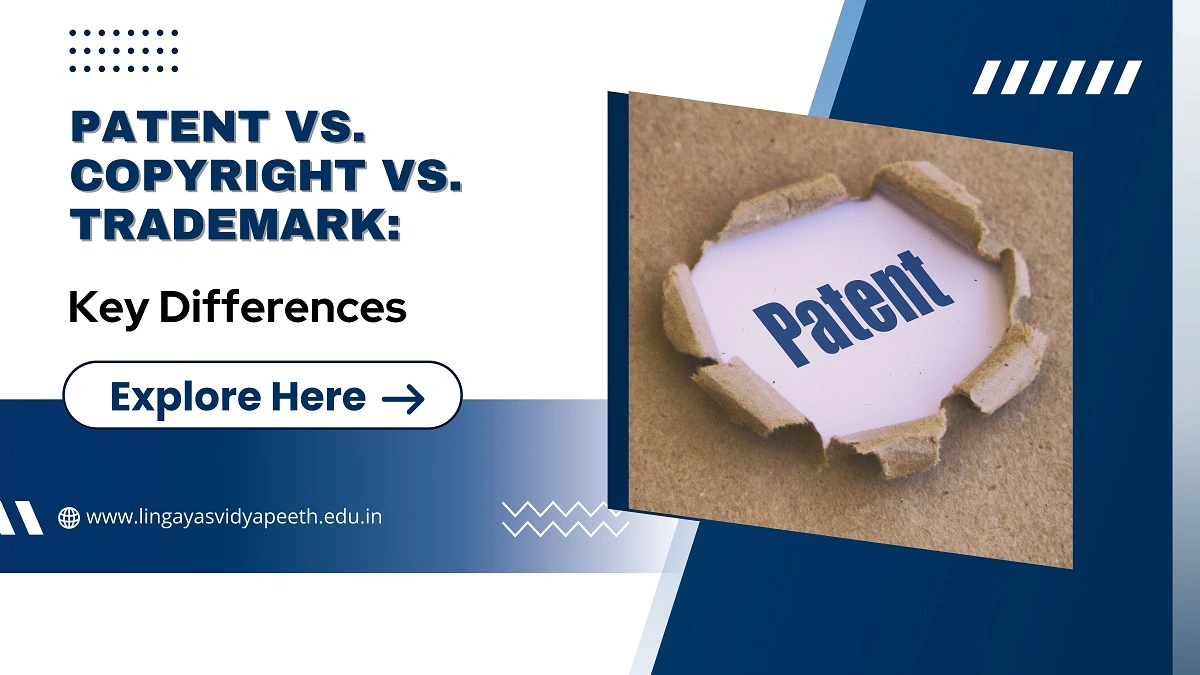Home » Patent vs. Copyright vs. Trademark: Key Differences

Ever wondered how people protect their cool ideas, creative works, or brand names? Imagine you invent a new gadget, write a catchy song, or create a unique logo for your startup. How do you make sure nobody steals them? This is where Intellectual Property Rights (IPR) play an important role! IPR is like a shield for your creations, and it includes three big players: patents, copyrights, and trademarks.
In this blog, we’ll break down what these terms mean, why they’re important, and how they differ. Plus, we’ll show you how Lingaya’s Vidyapeeth, with its awesome courses like LLB, BA LLB, and BBA LLB, can help you master IPR and kickstart a career in law. Let’s dive in!
A patent is like a special permission from the government that says, “Hey, this invention is yours, and no one else can make, use, or sell it without your okay!” It’s given to people who create something new, useful, and not obvious—like a new machine or technology.
Example: Imagine you invent a solar-powered phone charger that works twice as fast as others. A patent ensures nobody else can copy your charger for a certain time (usually 20 years in India).
Want to learn how to file a patent? At Lingaya’s Vidyapeeth, the LLB and BA LLB programs teach you all about patents and how to protect inventions legally!
A copyright safeguards your original creations—like writings, music, films, or even software code. It gives you the right to decide who can copy, share, or perform your work.
Example: If you write a novel about a magical school, a copyright ensures no one can publish or sell your story without your permission.
Curious about copyright laws? Enrol in Lingaya’s Vidyapeeth’s BBA LLB program to learn how to protect creative works and build a career in intellectual property law!
A trademark is a unique sign, logo, or name that identifies a product or service. It helps customers know your brand and sets it apart from others.
Example: The Nike swoosh logo is a trademark. It tells you the shoes are from Nike, not another company.
Want to create a brand and protect it? Lingaya’s Vidyapeeth’s LLB program teaches you trademark law and how to safeguard brand identities!
Here’s a simple table to show how patents, copyrights, and trademarks differ:
| Aspect | Patent | Copyright | Trademark |
| What It Protects | Inventions (new products/processes) | Creative works (books, music, art) | Brand identifiers (logos, names) |
| Duration | 20 years | Creator’s life + 60 years | 10 years (renewable) |
| Registration | Required, complex process | Automatic, registration optional | Required, simpler than patent |
| Example | A new type of battery | A novel or song | Nike’s swoosh logo |
| Purpose | Encourages innovation | Protects creativity | Builds brand identity |
| Scope | Product or process functionality | Artistic or literary expression | Brand recognition |
| Governing Law in India | Patent Act, 1970 | Copyright Act, 1957 | Trade Marks Act, 1999 |
| Who Can Apply? | Inventors | Authors, artists | Businesses, individuals |
| Cost of Filing | High (₹1,600–₹8,000 for individuals) | Low (₹500–₹5,000) | Moderate (₹4,500 for MSMEs) |
| Global Protection | Territorial (India-only unless filed internationally) | Recognized globally | Territorial, renewable globally |
Yes, patents, copyrights, and trademarks have some things in common:
o Cost: ₹1,600–₹8,000 for individuals; higher for companies.
At Lingaya’s Vidyapeeth, you can dive deep into the world of IPR through its top-notch law programs:
These courses teach you how to file patents, register copyrights, and protect trademarks. With expert faculty and hands-on training, Lingaya’s prepares you to become an IPR expert, helping businesses and creators safeguard their ideas. In 2024, Lingaya’s placed over 90% of its law students in top firms, making it a great choice for your future!
Patents, copyrights, and trademarks are your tools to protect inventions, creative works, and brand identities. Understanding these differences is key to securing your ideas and building a successful career. Join Lingaya’s Vidyapeeth! With courses like LLB, BA LLB, and BBA LLB, you’ll learn everything about intellectual property law and get a head start in a booming field.
Also Read
Difference between Marketing and Selling
Difference between Capital market and money market
Difference between Advertising and Publicity
Difference between Money market and Capital market
From
Lingaya’s Vidyapeeth
Best University in Faridabad
RECENT POSTS
CATEGORIES
TAGS
Agriculture Agriculture future AI Architecture artificial intelligence Bachelor of Commerce BA English BA Psychology BTech AIML BTech CSE BTech cybersecurity BTech Engineering Business management career Career-Specific Education career guide career option career scope Civil engineering commerce and management Computer Science Computer science engineering Data science degree education Engineering Engineering students English Literature english program Fashion Design Fashion design course Higher Education Journalism journalism and mass communication law Law career Machine Learning mathematics MBA MBA specialization Mechanical Engineering Pharmacy Psychology Research and Development students
Nachauli, Jasana Road, Faridabad, Haryana
Address: C-72, Second Floor, Shivalik, Near Malviya Nagar,
Above HDFC Bank, New Delhi 110017
Landline No. - 011-46570515 / 45138169 / 41755703
Mobile No. - +91-7303152412 / +91-7303152420 / +91-9311321952
Toll Free: 1800-120-4613
Mobile : 8447744303 | 8447744304 | 8447744306 | 8447744309
8700003974 | 8700003411 | 8700003749
Copyrights © 1998 - 2026 Lingaya's Vidyapeeth (Deemed To Be University). All rights reserved.
LV only conducts physical/online verification of any document related to examination on the following email id:
It is important to note that the following email IDs and domains are fraudulent and do not belong to our university.